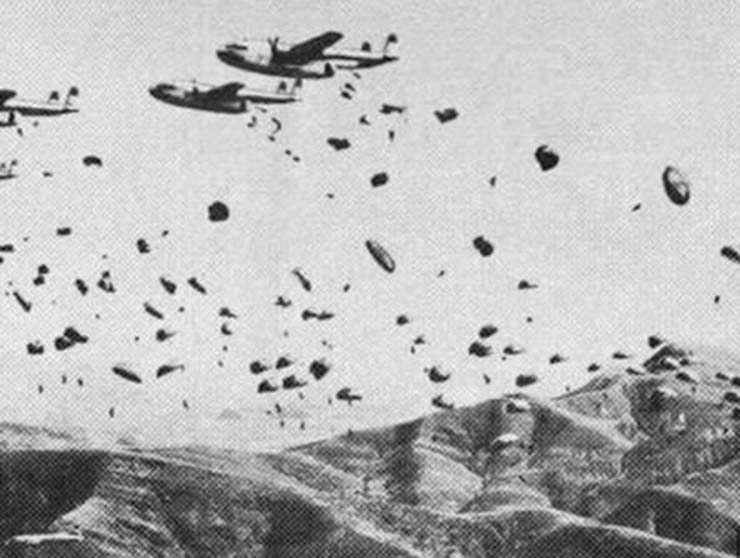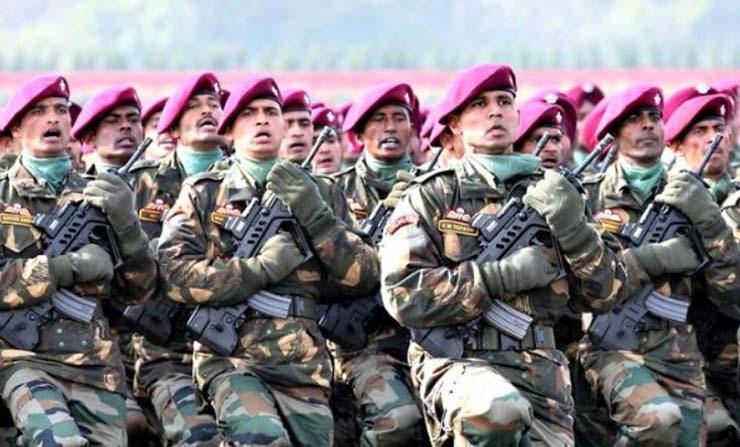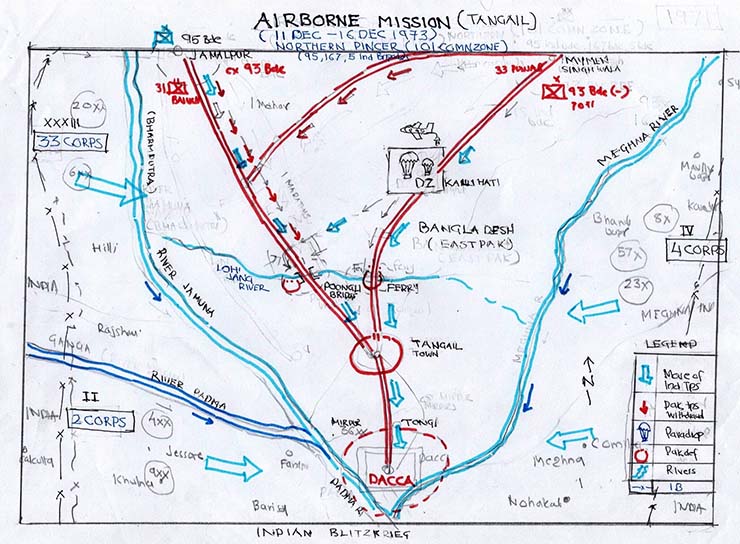
President Yahya Khan of Pakistan gave Operation Changez Khan the green signal, at 1730 hrs. on December 3, 1971. Pak Air Force’s F 86 Sabres, Mirages, and Star Fighters warplanes took off from Murid, Sargodha air base and bombarded 11 Indian airbases at Amritsar, Ambala, Agra, Awantipura, Nal, Halwara, Jodhpur, Jaisalmer, Pathankot, Bhuj, Srinagar and Uttarlai by 1830 hrs. for a pre-emptive strike against India.
Thus the Third India Pakistan War had begun, as Indian PM Mrs Indira Gandhi declared at a midnight address “We are at War with Pakistan”. The Indian Army under the command of General Manekshaw was fully prepared.
Indian warplanes not only retaliated ferociously in the western sector but also Four Army pincers were unleashed in East Pakistan. Indian forces’ blitzkrieg raced to Dhaka crushing all Pak Army formations. A new nation i.e. Bangladesh was born on December 16, 1971 within 13 days, after the start of the war.
The largest airborne operation ‘Operation Tangail’ after the WW II was undertaken by Elite 50 Para Brigade which was part of 101 Communication Zone
The largest airborne operation after the WW II was undertaken by Elite 50 Para Brigade which was part of 101 Communication Zone.
Operation Tangail, the air assault launched by 2 Para on December 11, 1971 was a daring maiden airborne mission since Independence by 50 Independent Para brigade. 2 Para was then part of the 50 Para brigade and commanded by Lt Col K S Pannu, MVC.
The group included 49 Para field battery ex 17 Para field Regiment, 411 Para field Engineer Company, 60 Para Medical team. 7 Para and 8 Para were other Para brigade units.
50 Para brigade was shifted from Agra to Howrah for anti-naxalite operations in January 1971 in West Bengal. 2 Para had camped in Botanical Garden in Kolkata in first week of November.
The warning order for a secret mission had been issued in the last week of November and preparation were in full swing for an operation, but ‘where’ was not known.
The Paratroopers boarded the convoy at midnight of December 9 and headed for Kalaikunda air base about 162 kms away, which was the mounting base. The logistics group headed for Dum Dum (now Netaji Subhash Chandra Bose International Airport) with heavy drop loads of supplies.
The troops were briefed about the airborne operation behind enemy lines and the load each one had to carry besides the main and reserve parachute. It included personnel weapons, first line ammunition, two grenades, 96 hours survival pre-cooked rations, a pair of uniform, water bottle, blanket and also an additional belt of MMG/Anti-tank rockets/Mortar ammunition to share the load of battalion support weapons crews.
The warning order for a secret mission had been issued in the last week of November and preparation were in full swing for an operation, but ‘where’ was not known
Paratroopers waited inside the hangers and relaxed on the tarmac. Final orders were disclosed on 10 December. Col K S Pannu briefed his company commanders that 2 Para has been tasked to launch an airborne assault to capture Poongli Bridge and a ferry point on River Louhajang near Tangail village, approximately 82 kms north west of Dhaka on Road Jamalpur/Mymensighwala and block the routes of enemy troops withdrawing from Jamalpur.
Indian Brigade troops were to link up with 2 Para after 24 hours advancing from the north. The company commanders further briefed the companies. The Airbase reverberated with Chatri Mata ki Jai.
The Pak 93 Infantry Brigade commanded by Brigadier Abdul Qadir held Jamalpur–Madhupur axis. The units under command were 33 Punjab, 31 Baluch, 70 Wing Rangers, 73 Wing Rangers, 83 Heavy Mortars battery and 5,000 Razakars (volunteers). 31 Baluch was located at Jamalpur and Lt Col Sultan Ahmad was the CO.
Brig Hardev Singh Kler, MVC, commander 95 Brigade sent a message to him to surrender as they were surrounded, but he sent a return message with 7.62 mm live bullet and conveyed that he would fight till last man and last bullet.
31 Baluch CO waited for an attack, which was not launched. Desperate, he decided to breakout from isolation towards Tangail. 1 Maratha had laid ambush and opened intense fire. 232 Baluch troops were killed and 61 were severely wounded.
The balance troops surrendered and taken POWs. 33 Punjab, survivors of 31 Baluch and brigade headquarters troops were now withdrawing on Tangail – Dhaka axis. Depleted 93 Brigade was gradually heading for Tangail while Op Tangail was underway.

22 Dakotas of 11 Squadron along with Caribous and AN 12 were ready at the Parking bay at 1100 hrs. on December 11. 2 Caribous were the first to take off and headed south and carried out Dummy Para drop, as part of a Deception Plan.
Fully loaded Paratroopers gradually mounted the aircrafts as Dakotas Turbo propellers humming with high RPM lined up on the side way. The first aircraft took off at 1420 hrs, followed by 21 more old Faithful and headed east towards the objective.
Pathfinders Group had already taken off about one hour before from Dum Dum Airport in two C II9 Fairchild Packets under Captain TC Bhardwaj. The Pathfinders landed at 1530 hrs, secured and marked the Dropping Zone (DZ).
There was covert Signal group already placed before Pathfinders with a secret team under “Peter”, which established the communication link and gave Green signal for the drop.
The first group of Dakotas cruised over the DZ and at 1630 hrs, the Paratroopers jumped out of exit gates and soon the sky was full of thousand White and Green parachutes descending from the sky.
DZ was located near Village Kalihati; spread over 1.5 x 1.5 kms. Within one hour, all paratroopers had assembled to the RVs and were ready for action as a cohesive unit.
Brig Hardev Singh Kler, MVC, commander 95 Brigade sent a message to him to surrender as they were surrounded, but he sent a return message with 7.62 mm live bullet and conveyed that he would fight till last man and last bullet
The villagers were surprised and were in doubt whether we were friends or foe. Paratroopers shouted Joy Bangla, Joy Hind. The locals also cheered back with Joy Bangla and Paratroopers received thousand helping hands.
The battalion finally assembled and headed for the Poongli Bridge, which was about 9 Kms away. 2 Para reached Poongli Bridge and ferry site, which was held by two platoons of 70 wing Rangers.
By 2200 hrs, both the objectives were achieved, eliminating the minor resistance by Rangers. Now the companies were deployed and they dug down on both sides of the bridge and ferry site.
Mukti Vahani fighters came rushing at 2300 hrs. and informed that Pakistani brigade units from Jamalpur were withdrawing and would reach the bridge by midnight.
The enemy convoy approached the bridge unaware that it was already held by the Indian troops. 2 Para opened fire from both sides once Pak troops were in firing sight.
Enemy troops suffered heavy casualties and disintegrated. 2 Para carried out reorganisation. On December 12 at 0900 hrs., an MI 4 landed with Maj Gen GS Nagra and Brig HS Kler, who had come to boost-up the morale of the troops and brought packed fresh food packets and also informed them that by last light 1 Marathas will link-up with them.
On December 13, local guides informed that Tangail had been abandoned. 95 Brigade also arrived and Tangail was occupied. Indian 95 Brigade now moved on the main axis Tangail–Dhaka and 2 Para moved on alternative axis and reached Mirpur, and was now almost overlooking at Dhaka.
On December 16, IAF bombers raided the Governor’s house and other important buildings and lot of leaflets were thrown from aircrafts asking Pakistani troops to surrender.
At 0900 hrs, a Chetak helicopter landed near Battalion HQ with Major General GR Nagra, commander 101 Area. He was jubilant and informed CO 2 Para that Pak Army has agreed to surrender and a message to Lt Gen AAK Niazi was to be sent.
The first group of Dakotas cruised over the DZ and at 1630 hrs, the Paratroopers jumped out of exit gates and soon the sky was full of thousand White and Green parachutes descending from the sky
The sporadic exchange of fire was still in progress on the other side of Mirpur Bridge. It was a dangerous situation of which Pak troops were not aware.
CO 2 Para detailed Captain Nirbhay Sharma to go with ADC Captain Harsh Mehta to go to Pak Eastern Command Headquarters at Dhaka in a Jeep and deliver the message of General Nagra.
Two more officers also boarded the Jeep and proceeded to Dhaka. This group was stopped by Pak garrison troops. The ADC handed over the letter to Pak Company Commander, who informed the Garrison Commander. Subsequently, Maj General Nagra and Maj General Jamshed of 36 Pak Division met at the Bridge and the situation was brought under control.
2 Para group and 1 Marathas convoy were the first Indian troops, which landed at Dhaka at 1042 hrs, on December 16, 1971 and took control of Dhaka city under Lt General Sagat Singh, IV Corps commander, who was also appointed as the overall force commander of Dhaka garrison.
There were few other related interesting incidents, too. Paratrooper Mahadev Gurao while jumping out could not exit properly and he got struck at the exit door, hanging in air for 30 minutes and his body hitting aircraft tail with force. Para Jump instructor detached his main parachute from the static line and he landed 50 miles away from the main body but survived and joined the unit after the war was over.

Capt Shamsher Singh GSO 3, Para brigade also jumped with 2 Para and also for the first time, a religious teacher also jumped as a Paratrooper with the troops.
The best part was the role of the foreign media. BBC War correspondent reported that the entire Para brigade had assembled at Dum Dum Airport and more than 5,000 Paratroopers had been dropped at various locations.
Lt General JFR Jacob has written in his book Birth of a Nation that this report played havoc with psyche of Lt Gen AAK Niazi and he agreed for an unconditional surrender.
The local Mukti Vahini leader Abdul Qadir Siddiqui aka “Tiger”, a young student leader from Dhaka University, his team and Captain PK Ghosh (Code name Peter) were helpful in marking and selecting the DZ for the Para group and securing the area.
Peter was selected by Lt General JFR Jacob, Chief of Staff, Eastern Command and was inducted a month before as an undercover agent and he joined Mukti Vahini fighters for success of the Para assault at Tangail. Later, he was awarded Veer Chakra.
2 Para group and 1 Marathas convoy were the first Indian troops, which landed at Dhaka at 1042 hrs, on December 16, 1971 and took control of Dhaka city under Lt General Sagat Singh
Operation Tangail was a unique operation of its kind undertaken post WW II by any Army in the world. The credit goes to 50 Para brigade commander Brigadier Mathew Thomas for detailed planning and selection of target.
CO 2 Para deserves special kudos for motivating his command for executing a difficult task in an unknown enemy area and he led from the front and lead paratroopers of 2 Para group, who had daringly volunteered for the dangerous mission and fought it bravely.
2 Para earned Battle Honour for the Poongli bridge attack and Theatre Honour for the Bangladesh war and was also decorated with one MVC (CO 2 Para), 6 Veer Chakras and 4 Sena Medals for the operation.
2 Para suffered three fatal casualties and few missing in action. 2 Para was selected for giving Guard of Honour at Dhaka Race Course during the Surrender Ceremony and on January 26, 1972, the unit was honoured to participate in the Republic day Parade, cheered by the entire nation.
Paratroopers are man apart and everyone is an emperor with motto Shatrujeet. Maroon berets are pride of the Indian Army.
-The writer is an Indian Army veteran and a defence analyst. He has keen interest in Geo-strategic affairs and writes regularly on internal and external affairs issues related to India and neighbours. The views expressed are personal and do not necessarily reflect the views of Raksha Anirveda















